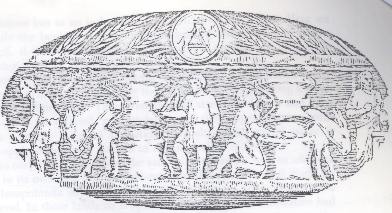 Chapter 7 Head oval.
Rotating hourglass mills from the tomb of M.Vergiliius Eurysaces, the Roman
slave who become an important miller. Above , a shop sign from Pompeii.
Chapter 7 Head oval.
Rotating hourglass mills from the tomb of M.Vergiliius Eurysaces, the Roman
slave who become an important miller. Above , a shop sign from Pompeii.Link:
Chapter 7 History of Milling: (copy for reference, because it is difficult to get now.)
From Storck,j.,Teague,W.D."History of Milling"From Canadian International
Grain Institute (Minnesota University Press,1952) via Copied Nisshin Flour Milling
Inc.
 Chapter 7 Head oval.
Rotating hourglass mills from the tomb of M.Vergiliius Eurysaces, the Roman
slave who become an important miller. Above , a shop sign from Pompeii.
Chapter 7 Head oval.
Rotating hourglass mills from the tomb of M.Vergiliius Eurysaces, the Roman
slave who become an important miller. Above , a shop sign from Pompeii.
Milling Becomes a Business:
To the substitution of circular for strait motion and of continuous for alternating ones, may be attributed nearly all the conveniences and elegancies of civilized life.
---- Thomas Ewbank
In the first millennium B.C. and in the eastern Mediterranean, the grinding of grain underwent two momentous changes, of such importance that they marked the beginning of new directions in human progress. First, the saddle-stone-rubber combination passed through a series of mutations whereby its size was enlarged and its action improved, increasing its output and requiring masculine strength for its operation. With the new equipment a man working all day could produce much more than one family's needs, creating a surplus for sale or exchange. As a result, milling for the first time became a professional activity, Iocated not in the home or a temple enclosure but in an independent industrial establishment. Here we have not only the beginning of commercial milling but perhaps of industrialism itself, if, as seems likely, it preceded the appearance of pottery factories using the kick wheel.
The second great innovation was the application of continuous rotary motion to grain-grinding, superseding the confused or reciprocating motion of all previous milling tools. Thereafter the full strength of men and even of animals could be utilized, greatly increasing the output. More significantly. This was the essential transition that ultimately would make it possible to apply nonorganic powers to useful work of all kinds.
It was no easy thing to improve the saddlestone, since it was an ultimate implement in its own line of development. No advance beyond it could be made in Mesopotamia or Egypt, where all techniques were frozen at a workable level. In these lands no incentive to change existed, initiative had no stimulus, deviation was discouraged. Even when the innovator was the Pharaoh, in the person of Ikhnaton, he found himself embalmed and laid away at an early age by a reverent but impIacable priesthood, guardians of the established ways. The early shifts toward modern mental attitudes and ways of life would occur in less static societies : in settings where life was not impossible but also not too easy, where there were difficulties to be overcome, where new social needs existed and these needs could be satisfied only by ingenuity and constructive effort. When agriculture was first imported into Mesopotamia and Egypt, those countries had possessed just such characteristics. Now the scene shifted to Troy, Crete, Phoenicia, Etruria, regions whose potentialities exceeded their present resources; to tiny, thin-soiled, poorly metaled Greece; later , to Carthago , on the edge of a desert, and to Rome, with her shallow and inadequate hinterland and deplorable harbors.
It was the Greeks who first attempted to understand the world - to grasp it in terms of the rational what instead of the dramatic who that had governed man's previous thinking. By this approach men would finally arrive at the skeptical, practical attitude essential to technological and scientific progress, which would regard nothing as finished or final, but would experiment constantly in search of improvement. It is a revealing fact that, although the mortar and saddlestone were the essential tools on which Egypt and Mesopotamia depended to make their grain crops assimilable). those tools were not radically changed or improved during thousands of years of incessant use. By contrast we can see in a collection of remains from the remain from the Island of Delos, how in a few score years the less rigid minds of the Hellenic peoples appropriated suggestions from man sources, and through trial and error evolved new master forms that revolutionized milling.
Figure 36 shows only a few of the combinations that were tried; there were dozens of others. Adding handle to the rubber permitted the use of larger stones and allowed the under stone to become flatter and more nearly rectangular than the usually concave saddlestone, the result being a type we shall call the slab mill. Grooving ("dressing") the meeting surfaces enabled them to hold the grain so that it would be cut open by a shearing action between the edges of the grooves, rather than be crushed by the direct pressure of the stones. From this time on it became customary to dress most millstones, and it soon became apparent that the shearing action was facilitated if the grooves were not parallel on the two stones, but crossed each other at a rather acute angle. The invention was a permanent addition to the technique of milling; even the rollers of modern mills are corrugated in this way.
Nor was this all. As the speed of grinding increased, the desirability
of feeding grain constantly between the stones without interruption of the work
became apparent. The larger upper stone made this practicable: a depression
or hopper was cut into it, with a slot at the bottom. The length and width of
the slot could be changed experiential)' until a rate of flow exactly until
a rate of flow exactly proportioned to the speed of grinding was obtained. Work
could proceed more continuously , but also the decrease in weigh of the hollowed
upper stone allowed a futher increase in its size , and this in turn accommodated
a larger hopper and a further prolongation of the grinding period.
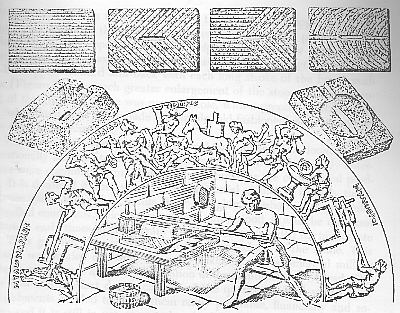
The semicircular reproduction is from a fourth-century B.C.
Megarian bowl, and shows a band of revelers disturbing operations in a bakery.
Two lever mills are shown, at either end of our depiction, and a single hourglass
mill, behind the donkey at the top. Beneath this reproduction is shown a reconstruction
of a lever mill in use. Above the semicircle, at the left and right, are shown
two kinds of upper stone; at the very top of the figure appear also four varieties
of dressing. The example at the far right would give the most uniform grind.
Originally long and narrow, the hopper now became in effect a large, rectangular, high-sided box with a grinding surface on its under side. We shall call this type the push mill, since most of the grinding was done as the operator pushed the rubber away from him. Even with its wooden crossbar handle, so large a stone was difficult to manipulate; so the meeting faces of the stones were often slanted away from the operator, and gravity aided the downward push. The stone was drawn back by swinging its sides alternately upward, By this time the push mill had become so large and heavy that few women could operate it, and so productive that only very large households would require one.
It occurred to someone that if he anchored one end of the handle of the push mill to a fixed pivot, he could use both his hands and arms on the other end, swinging the stone back and forth, in an arc of a circle. This lever mill called for a decided change in the shape of the upper and lower stones; for restoring the grinding surfaces to a horizontal plane; and for raising the whole apparatus to waist height, on a tab]e or base, so that the operator could stand upright and exert the whole stlength of his body as he stepped forward and back with each long stroke of the heavy push bar (Figure 37 ) . A much greater enlargement of the stones and lengthening of the grinding stroke was now possible, with a proportionate increase in yield which must have made the simple, old-fashioned saddlestone look like a mere feminine toy.
The lever mill was an industrial machine, outsize for domestic use, intentionally adapted to factories run by men for profit. These early enterprises were combination mill-bakeries, with bread as the commercial product. It is doubtful if flour was sold in substantial quantities in early times. Because grain keeps well, while flour is highly perishable except under controlled conditions which were not then understood, it was the universal custom in early times to grind grain only as flour was needed for immediate use. Thus grinding was a daily- and day-long-chore in the home. This practice was carried over into the early bakeries, and commercial milling made its appearance as the first operation in the manufacture of bread. The lever mill was the first device capable of the quantity output which such establishments needed to make them really profitable, financially and socially; and it is still in use, even today, in Greece - a fine example of the persistence of primitive tools. Requiring less skill and mental effort to use, and being cheaper to make, such tools are retained long after better appliances are available. The advanced devices themselves are apt to be superseded by further improvements, but workable elementary forms are seldom completely discarded.
In power applied, in its use of the lever principle, and in its mechanical uniformity of action, the lever mill stands far ahead of all other grinding devices we have described. Of course, we cannot be sure from the available evidence that the chronological order of invention was as neat as our account of it (Figure 38 ) : in a period of active innovation and experiment, some of the logically more advanced forms may have appeared out of turn. More significant than the exact order of their invention, however, is the fact that these improvements appeared in the same general area within a comparatively short period of time. Most of the Delian forms, including even the lever mill, have been found in settings dating from before the middle of the first millennium B.C., with examples cropping up in widely scattered places. But it was among the Greeks that aII of them made their appearance together and, in a period of less than one hundred years, underwent a rapid synthesis that set Western milling on the course of development it has followed ever since.
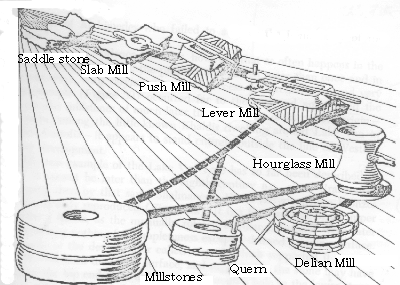
Figure 38. Possible lines of evolution from the saddlestone
to the millstone. The great leap came when the arclike motion of the Lever mill
gave rise to a mill using full rotary motion. In Creek areas, the hourglass
mill apparently preceded the quern; farther east the quern was reached by a
single step, made before 700 B.C. The hand-powered quern preceded the water
powered mills stone by at least three hundred years in the Mediterranean area;
farther east they may have come closer together.
A spur toward further improvement lay in the fact that the lever mill had grave deficiencies. There was no provision for automatic removal of the grist, which would accumulate between the stones or be pushed out just beyond the field of movement of the upper stone. Also, since the dead weight of the upper stone rested directly on the Iower, there was no way of regulating the degree of fineness, and the bran Was ground equally with the endosperm. Most important of all, there was a waste of effort since the motion was still reciprocal instead of continuous, and it could be managed only by a human being.
From the saddlestone to the lever mill we can follow a step-by-step sequence of development, and the arc of the lever mill's movement undoubtedly suggested the bul circle of a rotary mill. Between a completely rotary mill and anything that had gone before there is an intellectual Ieap of starling abruptness. We are in the presence, here, of positive invention at its creative best. As Curwen has said, "Such an advance could only have been the product of a brilliant engineer or mathematician - some forgotten forerunner of Archimedes who failed to achieve the immortality of the classics.
The available evidence indicates, however, that as often happens in the case of critical inventions the problem was solved more than once and in different ways, with varying degrees of success. One remarkable]e and early example (Figure 39 ) occurred far to the east and anticipated the flat, circular millstones of much later times. Because of its remote origin Urartu, among the little-known Khaldis dwelling around Lake Van in eastern Anatolia - it apears to stand entirely outside the line of Western milling development.
Only one example of the Lake Van type has so far been described
in print. It cannot be later than the eighth century B.C. since Urartu was conquered
then by that same Shalmaneser 3 of Assyria whose bronzes we have already reproduced
( Figure 3-9 ) . It is a fine example of an upper stone for a quern, as the
manually rotated circular millstones were later called, Iacking nothing for
completeness except a dressed grinding surface. The marks of the device, Iater
called a rynd, which supported it over its base are visible on the under surface,
and suggest that the stone may have rested on the top end of an axle passing
through a hole in the lower stone. This would have provided a crude means of
regulating the fineness of the grind, antieciating the much later arrangement
shown in Figure 48. The small holes for handles in the side of the hopper indicate
that it was turned manually.
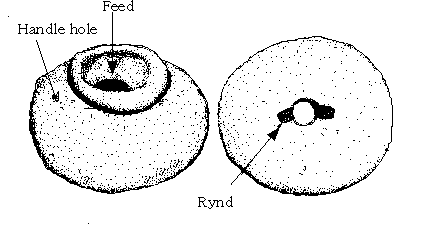
Figure 89. Upper quern stone, from Varaga in the Khaldi state
of Urartu, in the Lake Van region of eastern Anatolia, dating from about the
eighth century B.C. This is the earliest quern of which we have definite cognizance,
and is complete with not only hopper but rynd. Tseretheli, the Russian archeologist
who described it, is of the opinion that it was from a water mill, which mills
were of very early date along King Mcnuas's canal in this region; but its small
size - about 16 inches in diameter - and the three holes around the rim of the
hopper, for the insertion of turning levers, make this view untenable.
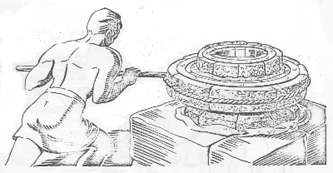
Figure 40. Delian mill, made of bound-together blocks of lava.
This mill is without a true hopper, although there is a slight space at the
top, between the stone rings. The outer ring rests directly on the inner ring.
This mill may be an adaptation of the hourglass mill, or transitional to it.
For technical perfection no less than for early date and out-of-the-way location, this quern stone is most remarkable.
Various other adaptations of rotary motion were made without effect on the later progress of milling, in these instances because of ineffciency. One such abortive device found at Delos, and apparently abandoned in favor of the more efficient hourglass type, is shown in Figure 40. This Delian mill was without a true hopper and without means of suspending the upper stone over the lower. Still another approach to rotary grinding is the edge runner, of early origin and used occasionally for grain grinding, but better adapted to crushing ores and other heavy materials (Figure 41 ). Because of its use for these purposes in South America, it is often called the Chile mill.
Figur41 Chile mill, or edge runner, used sometimes for milling,
but more likely to rush than grind the grain. It is more commonly use d for
crushing ore.
Figure 42 Hourglass mills shown in cutaway view to indicate alternative methods of mounting the catillus on the meta. The method of connecting the stones shown at the left is the better of the two, and was later applied to querns and to millstones, when the metal device became known as the rynd. Hourglass j mills have been found at various places in the Greek world, including the Island of Delos, and at Pompeii and numerous other locations in the Roman west.
The first adaptation of rotary motion to milling, sufficiently successful to launch a permanent trend, was a Greek invention. The critical problem in a rotary mill was to keep the grinding surfaces in virtually parallel planes. The Greek solution of this problem was to fit the two stones together as a mated pair of cones, which would be self-centering ( Figure 42 ) .
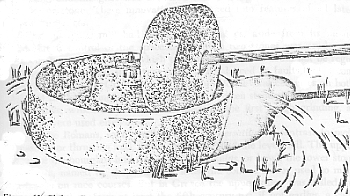
Figure 41 . Chile mill, or edge runner, used sometimes for milling, but more likely to rush than grind the grain. It is more commonly used for crushing ore.
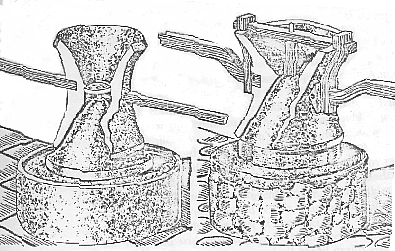
Figure 42. Hourglass mills, shown in cut way view to indicate alternative methods of mounting the catalus on the meta. The method of connecting the stones shown at the left is the better of the two, and was later applied to querns and to millstones, when the metal device became known as the rynd. Hourglass mills have been found at various places in the Creek world, including the Island of Delos, and at Pompeii and numerous other locations in the Roman west.
In addition the upper stone was enlarged above its waist into a second conical hollow about as big as the lower grinding compartment, making a hopper for continuous feed and giving the mill its hourglass shape. This upper stone could then be rotated steadily by man or beast, pushing or pulling the wooden crossbars. Since the upper stone was supported above the lower stone by the rynd, a grinding space between the two was provided. The big hopper could easily be refilled by a helper without pause in the grinding, and the grist was delivered into a trough around the base of the lower stone. These innovation developed into features of all later milling practices.
The hourglass mill had certain shortcomings, aside from its innate clumsiness: control of the space between its two stones was crude and inaccurate, and the rate at which grain was fed into it could not be regulated accurately. Still, its virtues so far overbalanced its faults that it continued in use in the Greek and Roman world for several centuries on both sides of the beginning of the Christian era. It often stood side by side with lever mills, which may have been used for the first rough grinding, as mortars were used elsewhere.
To the Romans, rotary mills were mola versatilis, in contrast to mola trusatilis, or thrusting mill, which we have called the lever mill. The upper stone of the hourglass mill was called the catillus, or bowl, the lower stone the meta, named by shape analogy after the conical stones used to mark distances on race courses. But in Creece the upper stone was called the onos; or donkey, from at least the fifth century B.C. if not earlier, a clear indication of the promptness with which animal power was utilized once the rotary principle had been adopted. This marks the first known use of animal power in milling; the first use, in fact, of non-human power of any kind except for those devices we have cited, more ingenious than capable of further development, which helped operate heavy pestles in mortar pounding.
Human power, slaves for the most part, continued to be used, and the lot of both humans and animals was anything but a happy one. In Apuleius' The Golden Ass, dating from the first part of the second century A.D., the hero was turned into a donkey by a magic potion and sold to a bakery. He thus describes the poor unfortunates of the mill, from which we can well understand why millers were in such bad repute among Greek and Roman writers : "Cood Lord, what broken down men were the lot I saw there! Their backs and shoulders, which were protected only by ragged cloaks, were cut and seamed by blows from the whip. Their heads were half shaved, and their brows branded[, to prevent escape. Their ankles were fettered in heavy chains. They were covered with a conglomeration of meal and ashes, just as athletes are with the dust of the circus."
In spite of the long and widespread popularity of the hourglass mill for industrial milling, by far the greater part of all bread grains continued to be ground in the home for two thousand years after industrial milling began. For domestic use the hourglass mill was too large, too expensive, and too difficult to operate. But the advantages of continuous circular motion, with the grain fed downward between the stones from an ample hopper above, Ied to the adaptation of these principles to a more modest home appliance, Abandoning the hourglass form with its necessarily massive proportions, two circular stones of manageable size, were fitted to each other with a slight conical rise toward the center of the two grinding surfaces slippage being prevented by a central pivot. The hopper and rind in the upper stone were retained, and a crank handle in the latter made it posible for a woman to turn it without immediate exertion.
The many superiorities of the quern, as it was called later in its history, caused it to supersede the saddlestone for home milling among all but the slab mill, the push mill, the lever mill, and the hourglass mill all were transitional forms and passed out of general use after classical times. But the quern was so much more efficient than any hand mill hitherto devised, and so well adapted to small-scale, family production, that it continued in use as long as grain was ground in the home and still serves to supply domestic needs in some more static parts of the world. It has even greater historical interest as the direct ancestor of the circular millstones used in water and windmills.
The quem was in use in many parts of the Mediterranean world by the fifth century B.C., and only a little later it had spread to the Celtic tribes of Caul and Spain. Pliny says that it was invented by the Volsinians, members of the pre-Roman Etruscan federation, but Pliny's historical accuracy is often questionable. He of course could have no knowledge of its exceedingly early use near Lake Van. It is more than Possible that a device so efficient was invented more than once, in widely separated areas, as soon as the principle of rotary motion had been mastered; Figure 43, for example, shows rotary mills from Palestine and India which may not have had a common ancestor.
As we have seen in our day, military urgencies are often a more powerful spur to technical and scientific progress than the milder pressure of civilian needs, and in classical times there existed the modern necessity of feeding large armies on the march and fleets at sea. At that time neither troops nor ships could carry a supply of perishable flour - they must carry grain and grind it to meet their daily, needs. In military camps and on shipboard the size and weight of the hourglass mill or even the lever mill would have been burdensome, and the need for a lighter, efficient mill hastened the development and spread of the quern. Xenophon in his Cyropaedia remarks on an army's need for hand-milling equipment.
Figere 45. Pre-Roman Celtic mill from the Auvergne, F.Tan:e, shown in cutawav view to display the unusual method of mounting. About 150 querns were discovered at a single location, al] of this type. Note the slanting mating surface between the two stones; also the horizontally extended handle, which would lave made rotation difficult.
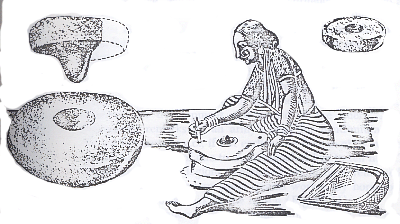
Figure 43. Early Palestinian and Hindu querns. At the
left, a grain quern from Gezer, with a maximum diameter of about 10 inches,
dating from a century or so B.C., which may have been derived from considerably
earlier small "paint grinders" similar to the one at the upper right.
These stones had no crank for turning, and may have been worked back and forth
in a half-circle. In the center, a Hindu woman using a crank-rotated quern of
about the same age as the Palestinian grain implement.
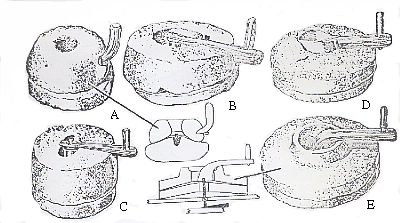 .
.
Figure 48. Early British querns. A, pre-Roman Wessex type ; note method of mounting upper stone by means of a peg. B, pre-Roman ,from the Trundle ,. Sussex , from before 50 B.C. C, probably from Iver, first century A. D, D from Hassocks,Sussex ( second century A.D) ; note separate hopper . E,from Thundersbilrrow Hill, Sussex (fourth century A.D.); note device for tentering the upper stone.